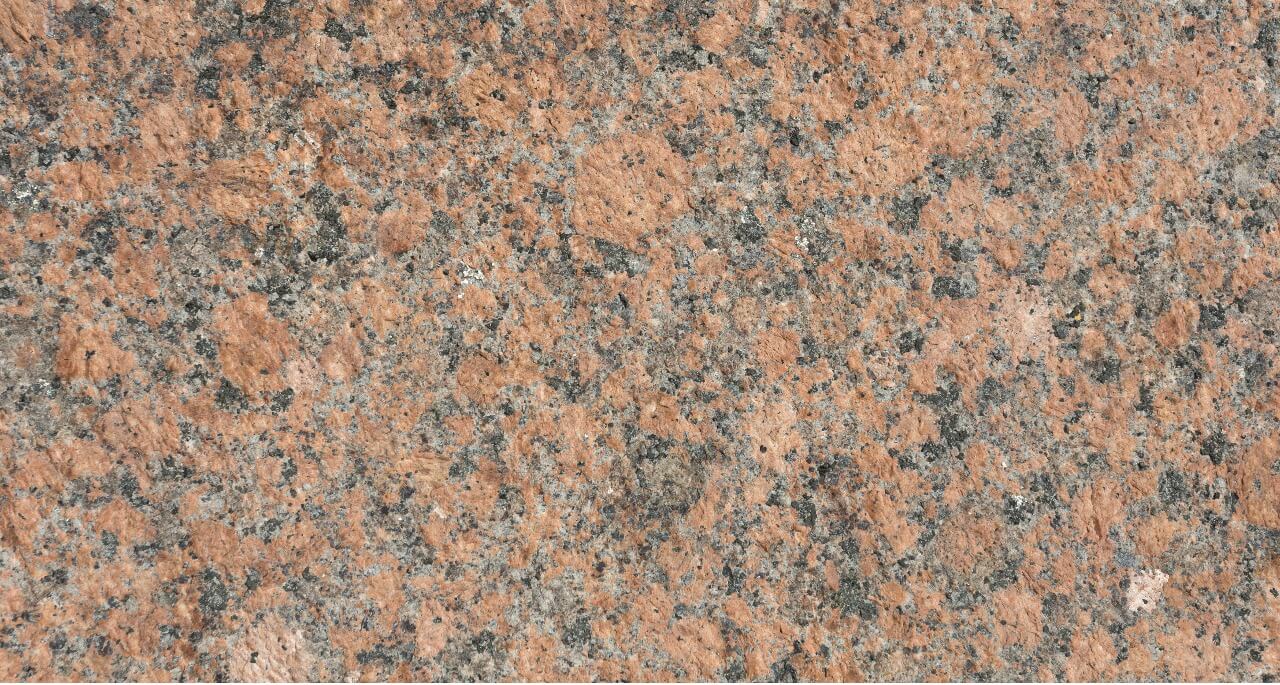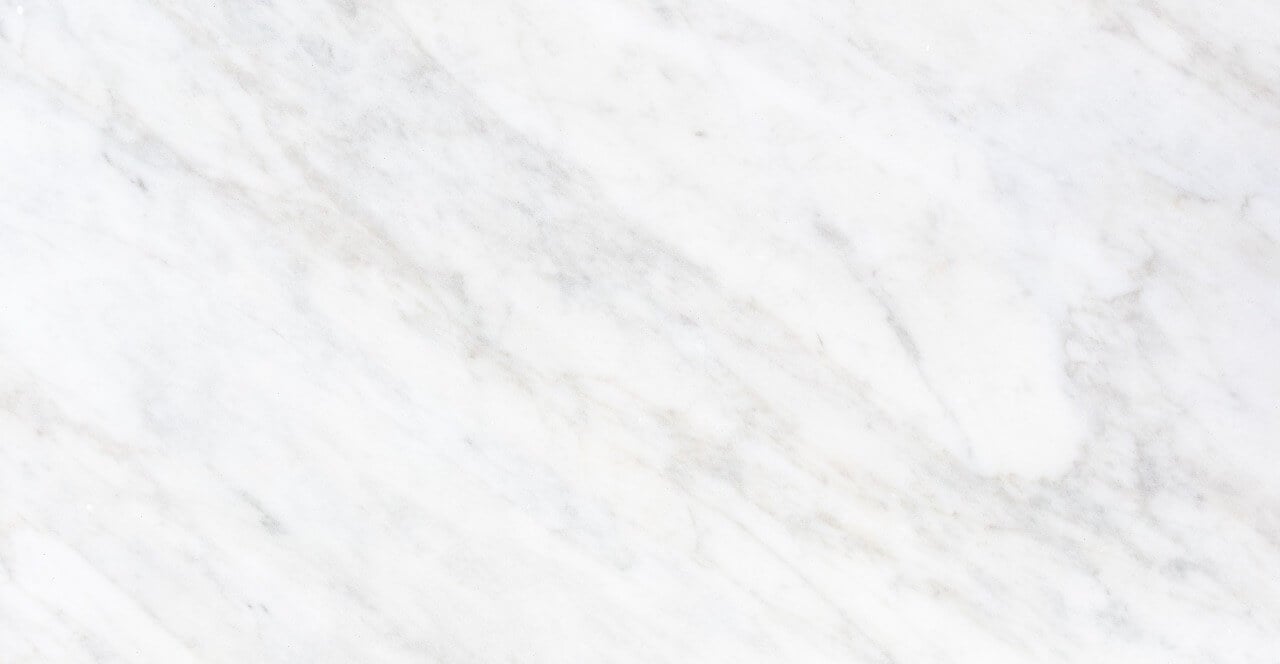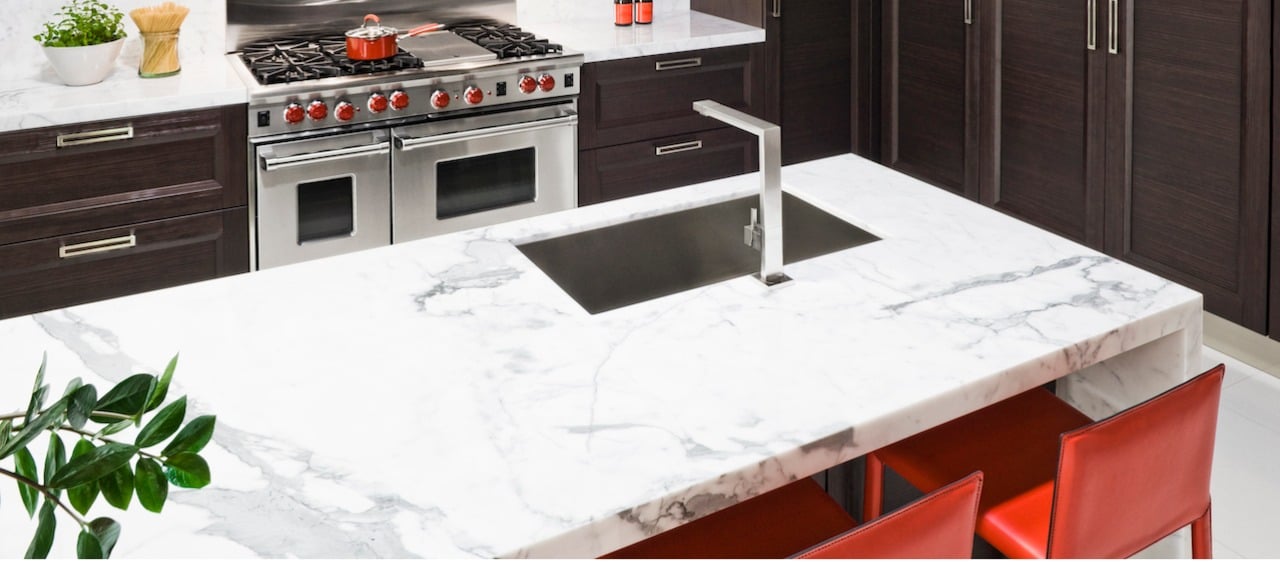

Left/Top: © RonFullHD/iStock / Getty Images Plus/Getty Images.
Bottom/Right: © R.Tsubin/Moment/Getty Images.
When deciding between granite or marble countertops, you’ll want to consider the differences in appearance, material, price, and more. Marble, with its distinctive appearance, is regarded as the ultimate luxury material, while granite gives you the look of natural stone and is extremely durable. Our guide will help you choose between marble versus granite for your next home improvement project.
On This Page:
- What Is Marble?
- What Is Granite?
- Appearance
- Cost
- Upkeep
- Durability
- Installation
- Life Span
- Environmental Impact
- Resale Value
- Is Marble or Granite Better for Your Home?
- Marble and Granite vs. Other Options
What Is Marble?
Marble is a metamorphic rock that’s transformed out of sedimentary stone. Originally, marble began as limestone and metamorphosized into marble under extreme heat and pressure. The primary component is calcium carbonate, which has softer elements than granite. Marble’s characteristic veining comes from other minerals captured during the metamorphic process.
The most common types of marble for home renovation include the following:
- Carrara: The most common marble used in home projects, Carrara marble is white to light gray, with light, feathery veining in medium to dark gray.
- Calacatta: This marble is rare and highly sought-after. It’s similar to Carrara, but the white is brighter and the veining darker and thicker.
- Emperador: Mined in Spain, Emperador marble ranges in color from light to darkest brown. The veining is usually brilliant white, creating a dramatic, impactful look.
- Crema Marfil: Popular for flooring and marble mosaics, Crema Marfil is Spanish marble. It’s available in varying shades of light beige-yellow with gray veining that varies in intensity.
- Levadia Black: This Greek marble is black with gray to white veining. It’s popular for contemporary countertops and features smoke spot veining.
- Nero Marquina: This is a jet-black Spanish marble with striking white veining popular in contemporary spaces and sought-after for its scarcity and opulence.
Other types of marble countertops include Statuario, Danby, cultured, Makrana, and pink.
What Is Granite?
Granite is an igneous rock formed from slowly cooling magma millions of years ago. During the cooling process, mineral crystals developed, giving granite its distinctive appearance. Quartz and feldspar are the dominant minerals in granite, along with mica, potassium, and amphiboles.
Granite is available in a variety of colors based on mineral composition. Popular colors for home interior projects include the following:
- White
- Beige
- Green
- Blue
- Brown
- Red
- Black
When choosing new countertops, you’ll want to factor in appearance, cost, upkeep, durability, installation, life span, environmental impact, resale value, and more. We’ll discuss the features of marble versus granite kitchen countertops below.
Appearance
Both marble versus granite countertops are visually appealing and unique. Granite is known for showing colorful specks, whereas marble has larger, more concentrated veining running through it.
| Marble | Granite |
|---|---|
| Elegant veining | Natural stone |
| Wide selection of colors | Wide selection of hues |
| Wide selection of styles | Wide selection of styles |
| Each slab is unique | Each slab is unique |
Marble

© PBNJ Productions/Getty Images.
Marble has a timeless, elegant look that’ll elevate your kitchen. Because marble originates from limestone around the world, each slab is unique in color and design. Marble is available in a wide range of colors with beautiful veining, making it a favorite for both contemporary and traditional kitchens and bathrooms.
Granite
Due to its natural stone appearance, granite truly transforms the look of a kitchen. Between the large variety of colors, hues, and styles in both light and dark colors, granite gives your kitchen or bathroom countertops a classic flair.
Cost
Cost is one of the primary factors when choosing a material for remodeling. Natural stone, such as marble and granite, is usually more expensive than synthetic materials, but stone is also longer lasting and more durable. Here are the typical range costs for marble versus granite:
| Marble Average Cost Range | Granite Average Cost Range |
|---|---|
| $2,000 – $5,000 | $2,250 – $4,500 |
Marble
Marble countertop costs are typically more cost-prohibitive than granite, coming in between $40 and $100 per square foot, with an average price of $60 per square foot without installation. Marble countertop costs will depend on several factors, such as the size of your countertop, the type of marble, and any enhancements you decide to make.
Granite
Granite countertop costs will run between $40 and $60 per square foot for basic slabs and between $75 and $100 per square foot without installation for specialty colors, such as red and blue. You can also expect to pay more for larger granite slabs and if you add complex patterns, such as unique swirls and streaks.
Upkeep
Both marble and granite countertops are relatively easy to clean, but both materials also require regular maintenance and upkeep. So you’ll need to factor in the costs to polish and restore your countertops into your overall price. Here are the average costs to deep clean and reseal marble and granite:
| Marble Cleaning and Resealing Cost Range per Sq. Ft. | Granite Cleaning and Resealing Cost Range |
|---|---|
| $4 – $12 | $4 – $6 |
Marble
Because marble is a naturally porous stone, you’ll need to carefully clean your countertops with a neutral cleaner, such as mild dish soap. Avoid anything abrasive, as it could strip and dull the finish. In terms of yearly maintenance, you’ll want to reseal your marble countertops twice a year to keep them in good condition. If you need to repair chips and cracks, you can expect to pay $20 per square foot or more for that service.
Granite
Granite is relatively easier to keep clean, and you can use mild detergent and hot water to keep your countertops looking new. You’ll want to avoid any acid or alkaline cleaners, as these could damage your granite. To properly maintain granite countertops, apply a fresh sealant once a year. You can expect the cost of restoring your granite countertops to run an average of $7 per square foot.
Ready to start your countertop installation?Durability
Both marble and granite are resilient countertop materials that can withstand heat. Yet, granite is a tougher material that better resists scratches than marble. The cost to repair your countertops will run between $200 and $500, depending on the type of damage. Here are examples of the durability of marble versus granite:
| Marble Durability | Granite Durability |
|---|---|
| Heat-resistant | Resists scratches, chips, and cracking |
| Strong 3 – 5 on the Mohs Hardness Scale | Strong 6 – 7 on the Mohs Hardness Scale |
Marble
Marble is elegant and robust, with high resistance to heat. But marble is also less resistant to scratches and chipping. And if anything acidic, such as lemons, is left on your countertop, it could etch the marble surface. If your countertop requires marble restoration services, you can expect to pay between $6 and $40 per square foot for repairs.
Granite

© grandriver/E+/Getty Images.
Granite is the preferred countertop choice for busy kitchens due to its high resistance to heat, scratches, and chipping. If you drop a knife on a granite countertop, you can rest assured it won’t scratch the surface.
However, granite is susceptible to chipping on its edges and corners—and it’ll crack or chip if a heavy object falls on it. You can expect a granite countertop repair service to charge between $6 and $40 per square foot.
Installation
For installation, marble and granite countertops use the same methods, and we recommend that a professional tackle this project. You can expect the cost to install or replace countertops to run between $1,860 and $4,300. Additionally, labor costs add around $300 to $1,650 to this project.
Here are the typical countertop installation costs, including labor, per square foot:
| Marble Installation Cost Range per Sq. Ft. | Granite Installation Cost Range per Sq. Ft. |
|---|---|
| $50 – $180 | $50 – $130 |
Marble
We recommend hiring a marble contractor near you to install your countertops. Pros not only know how to cut marble slabs properly but also know how to install and seal your countertop correctly.
If you DIY this project, you’ll need several helping hands, as marble is very heavy. Also, you won’t have the expertise to properly place marble’s beautiful veining within your kitchen or bathroom.
Granite
Like marble, we recommend hiring a granite countertop installer near you to ensure your countertop fits perfectly. Granite pros understand how to hide seams and seal your countertop to keep it in excellent condition. Granite is also very heavy, so you’ll need several helpers if you choose to DIY this project.
Life Span
Both marble and granite are highly durable and can last many years with the proper care. When remodeling, the cost of cabinets and countertops plays a significant role, which is why choosing a long-lasting natural stone countertop is essential.
Here’s the expected longevity of marble versus granite countertops:
| Marble Life Span | Granite Life Span |
|---|---|
| 20 – 50+ years | 100+ years |
Marble
Marble has always been a luxurious addition to any kitchen or bathroom. But marble is softer than granite, so it’s more susceptible to scratches, stains, and damage. Marble countertops usually last around 20 years, but with proper maintenance and regular sealings, they can last beyond 50 years.
Granite
Granite is the stronger stone of the two. It can truly last a lifetime—or for 100 years or more. Granite will remain beautiful if you maintain and keep it free from scratches and chipping. It also requires regular sealings to keep it in great condition.
Environmental Impact
Although granite and marble are natural materials, the mining process isn’t environmentally friendly. Plus, marble and granite take millions of years to form, so they’re not sustainable materials. However, these hard-wearing, resilient stones have been around for millions of years and will last for many lifetimes with minimal care.
Therefore, making a more sustainable choice for your home renovation project is possible by choosing remnant or reclaimed stone. It’s reasonably easy to find granite or marble remnants and reclamations. Additionally, reclaimed stone often has an interesting story that’s a conversation starter and adds a little history to your living space. Talk to a stone and granite fabricator to help you with ideas for using remnant or recycled materials for your countertop project.
Marble
While marble isn’t a sustainable material, it has longevity, so you won’t be replacing your countertops every few years. Marble is also recyclable, and you can transform it into shelves, small tables, and other decorative wares.
Granite
Much like marble, granite isn’t sustainable. But because granite lasts a lifetime, you won’t need to worry about replacing it in the short term. Granite also has many recyclable qualities since many homeowners donate their old countertops. Or, you can make custom designs, such as tables, shelves, wall decor, and more.
Resale Value
While you may not be planning to sell your home immediately, resale value is still an important consideration. The money you’re investing in remodeling your home should be equaled or increased in the uplift in your home’s value. While both marble and granite are popular for kitchen remodeling, you’ll want to ensure you choose a countertop material proportional to your home’s overall value.
Marble
If you have a higher-priced home, marble countertops will provide added resale value. But you’ll want to maintain your marble continually. Worn-looking marble that no longer shines won’t offer the same resale value as polished and sealed marble.
Granite
Granite is among the most popular choices for kitchen counters. And it can add 100% or more of the installation cost when selling your home. However, if you choose dark colors, you risk your countertop going out of style. So, make sure to select an elegant color and maintain your granite for the long run.
Is Marble or Granite Better for Your Home?
Marble and granite are both durable choices for your home. They add value and have many pleasing qualities that can elevate a space. Ultimately, the decision comes down to preference, price, and lifestyle. You’ll want to speak to a countertop installer near you who can help guide you, depending on whether you’re planning to add a new countertop to your kitchen, bathroom, or another home project. Finally, our helpful countertop calculator can help you budget and understand the true costs of marble versus granite countertops.
| Factors | Marble | Granite |
|---|---|---|
| Appearance | Elegant veining | Lots of colors |
| Cost | $40 – $100 per sq. ft. | $40 – $60 per sq. ft. |
| Upkeep | More maintenance | Less maintenance |
| Durability | Less durable | More durable |
| Installation | $50 – $180 per sq. ft. | $50 – $130 per sq. ft. |
| Life Span | 20 – 50+ years | 100+ years |
| Resale Value | May add value | More popular value |
Kitchen Countertops
Granite is the better choice for kitchens. With its resistance to heat and a higher tolerance for acidic food spills, it’ll continue to look good and require less diligent care than marble. Marble is a viable option, but be aware that it requires frequent sealing, careful cleaning, and diligence in cleaning spills.
Bathroom Countertops
Either stone works well for bathroom countertops. Because it usually won’t face spills from acidic foods, the bathroom is a great place to leverage marble, although you must ensure that you keep it sealed to resist the moisture it’ll face. For the shower, granite is a better option because while it does need sealing, it’s less prone to water damage than marble.
Fire Surrounds
Marble and granite are tied closely for fireplace surrounds. For the classic white fireplace surround seen throughout history, marble is the way to go. It requires more cleaning and regular sealing, but its timeless elegance is undeniable.
Marble and Granite vs. Other Options
You’ll find many alternatives to granite and marble, ranging from natural stones like limestone to synthetics like solid surface and resin, as well as recycled materials such as glass.
Vs. Quartz
Quartz countertops come from artificial stone slabs. It looks like natural stone and has many of the same beneficial properties. However, compared to granite, quartz isn’t as durable. It can fade with prolonged exposure to UV light and isn’t as heat resistant. Read more about quartz versus granite countertops here.
Vs. Concrete
Concrete countertops are elegant and sleek. And the typical cost of concrete countertops is comparable, between $2,100 and $4,000. However, compared to marble and granite, concrete is more porous and only has a life span of around 20 years, and you can expect more scratching and crumbling.
Vs. Soapstone
Soapstone countertops cost less than granite and marble, so it’s an economical compromise for those who want real stone but are on a tight budget. It’s heat-resistant and less prone to staining than both granite and marble. Unlike granite and marble, it’s resistant to acids like lemon juice and nonporous, so it doesn’t require sealing. On the other hand, it’s soft and scratches easily.
Ready to start your countertop installation? Cheap Kitchen Countertop Alternatives to Granite
Cheap Kitchen Countertop Alternatives to Granite  A Fresh Look at Kitchen Countertops
A Fresh Look at Kitchen Countertops  Preparing For a New Kitchen Countertop
Preparing For a New Kitchen Countertop  Stainless Steel Counters Turn Amateur Cooks into Sleek Chefs
Stainless Steel Counters Turn Amateur Cooks into Sleek Chefs  Quartz vs. Granite Countertops
Quartz vs. Granite Countertops 

Great article! Completely agree with you. Granite performs much better when it comes to durability. All it needs is a sealant every 10 to 15 years. And you do not need to worry about oil, water, heat, or acidic food.